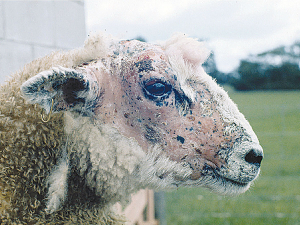2024/25 Dairy Statistics: NZ dairy farmers boost production with fewer cows
According to the New Zealand Dairy Statistics 2024/25 report, New Zealand dairy farmers are achieving more with fewer cows.
 Until recently, Sporidesmin, the toxin responsible for FE, was thought to be made by the fungus Pseudopithomyces chartarum.
Until recently, Sporidesmin, the toxin responsible for FE, was thought to be made by the fungus Pseudopithomyces chartarum.
A breakthrough in the understanding of Facial Eczema (FE) in livestock could bring New Zealand closer to reducing the disease’s impact.
Until recently, Sporidesmin, the toxin responsible for FE, was thought to be made by the fungus Pseudopithomyces chartarum.
However, researchers from AgResearch, Manaaki Whenua, Beef + Lamb New Zealand (B+LNZ) and Livestock Improvement Corporation (LIC) have shown that few Pseudopithomyces chartarum strains appear capable of making sporidesmin, and a new species, Pseudopithomyces toxicarius, is the primary sporidesmin producer, providing a clearer understanding of the disease’s causes, and paving the way for more effective control strategies.
FE has cost the New Zealand economy an estimated $332 million annually.
Dan Brier, B+LNZ’s general manager of farming excellence, says FE has been a long-standing challenge for farmers.
“This research is a vital step toward understanding the fungus and ultimately eliminating its impact,” Brier says.
“Identifying the species responsible gives us a clearer foundation for developing more accurate diagnostic tools and effective management practices. This collaboration highlights the importance of working together to solve this issue, and we’re proud to contribute to this breakthrough,” he says.
“Bringing together farmer-led organisations and researchers is key to delivering practical outcomes that truly make a difference on the ground. By combining real-world farming experience with scientific expertise, we ensure that research is not just theoretical but directly applicable to the challenges farmers face every day," adds Brier.
Dr Bevin Weir, senior scientist at Manaaki Whenua says the findings are the result of years of hard work and dedication from research teams and the farming community.
“Identifying Pseudopithomyces toxicarius as the primary cause of Facial Eczema is a critical step forward and a testament to the commitment of everyone involved.”
As B+LNZ’s Eliminating Facial Eczema Impacts (EFEI) programme continues its work, this collaborative research from Beef + Lamb New Zealand, AgResearch, Manaaki Whenua and LIC represents a crucial step in solving the challenges of Facial Eczema.
When American retail giant Cosco came to audit Open Country Dairy’s new butter plant at the Waharoa site and give the green light to supply their American stores, they allowed themselves a week for the exercise.
Fonterra chair Peter McBride says the divestment of Mainland Group is their last significant asset sale and signals the end of structural changes.
Thirty years ago, as a young sharemilker, former Waikato farmer Snow Chubb realised he was bucking a trend when he started planting trees to provide shade for his cows, but he knew the animals would appreciate what he was doing.
Virtual fencing and herding systems supplier, Halter is welcoming a decision by the Victorian Government to allow farmers in the state to use the technology.
DairyNZ’s latest Econ Tracker update shows most farms will still finish the season in a positive position, although the gap has narrowed compared with early season expectations.
New Zealand’s national lamb crop for the 2025–26 season is estimated at 19.66 million head, a lift of one percent (or 188,000 more lambs) on last season, according to Beef + Lamb New Zealand’s (B+LNZ) latest Lamb Crop report.

OPINION: Your old mate welcomes the proposed changes to local government but notes it drew responses that ranged from the reasonable…
OPINION: A press release from the oxygen thieves running the hot air symposium on climate change, known as COP30, grabbed your…